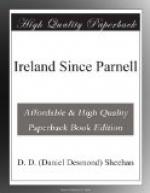But, alas! for the belief, the chieftain had only too surely passed away, and when the General Election of 1895 was over it was a battered, broken and bitterly divided Irish Party which returned to Westminster—a Party which had lost all faith in itself and which was a byword and a reproach alike for its helpless inefficiency and its petty intestine quarrels.
CHAPTER VI
TOWARDS LIGHT AND LEADING
Whilst the slow corruption of the Party had been going on in Ireland, the cause of Home Rule had been going down to inevitable ruin. The warnings on which Parnell founded his refusal to be expelled from the leadership by dictation from England were more than justified in the event. And later circumstances only too bitterly confirmed it, that any blind dependence upon the Liberal Party was to be paid for in disappointment, if not in positive betrayal of Irish interests. A Tory Party had now come into power with a large majority, and the people were treated alternately or concurrently to doses of coercion and proposals initiated with the avowed object of killing Home Rule with kindness. This had been the declared policy of Mr Arthur Balfour when his attempt to inaugurate his uncle Lord Salisbury’s policy of twenty years of resolute government had failed, and when, with considerable constructive foresight, he established the Congested Districts Board in 1891 as a sort of opposition show—and not too unsuccessful at that—to the Plan of Campaign and the Home Rule agitation.
With the developments that followed the Irish Party had practically no connection. They were neither their authors nor instruments, though they had the sublime audacity in a later generation to claim to be the legitimate inheritors of all these accomplishments. Mr Dillon had now arrived at the summit of his Parliamentary ambition—he was the leader of “the majority” Party, but his success seemed to bring him no comfort, and certainly discovered no golden vein of statesmanship in his composition. The quarrels and recriminations of the three sectional organisations—the National Federation of the Dillonites, the National League of the Parnellites, and the People’s Rights Association of the Healyites—continued unabated. But beyond the capacity for vulgar abuse they possessed none other. Parliamentarianism was dying on its legs and constitutionalism appeared to have received its death-blow. The country had lost all respect for its “Members,” and young and old were sick unto death of a movement which offered no immediate prospects of action and no hope for the future. A generation of sceptics and scoffers was being created, and even if the idealists, who are always to be found in large number in Ireland, still remained unconquerable in their faith that a resurgent and regenerated Ireland must arise some time, and somehow, they were remarkably silent in the expression of their convictions. Mr William O’Brien thus describes the unspeakable depths to which the Party had fallen in those days:




